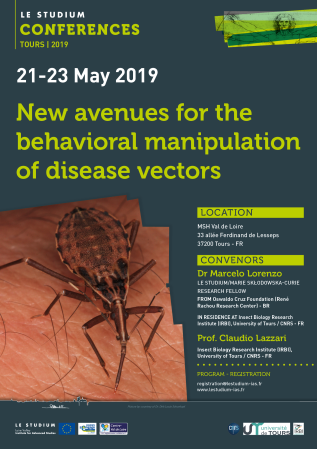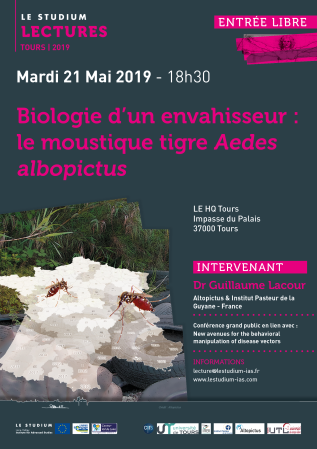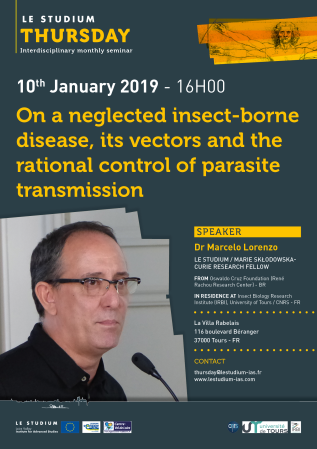Dr Marcelo Gustavo Lorenzo

From
Oswaldo Cruz Foundation (René Rachou Research Center) - BR
In residence at
Insect Biology Research Institute (IRBI), University of Tours / CNRS - FR
Host scientist
Prof. Claudio Lazzari
PROJECT
Genomics of learning and memory in disease vector insects
Vector-borne diseases are among the most devastating problems in public health. An important part of the efforts for developing new control tools concerns understanding the biology of vector insects and its impact on parasite transmission. The study of activity rhythms, sensory ecology, mating systems, behavioral physiology and chemical ecology has received much attention, providing novel insight to hinder the circulation of parasites in human populations. However, despite their important adaptive role, the learning abilities of disease vector insects remain poorly studied. Furthermore, the impact of individual experience on the transmission of pathogens is mainly ignored. The IRBI has advanced this area of knowledge in the last decade and the wealth of information gathered allows further exploration of this frontier of science. The objective of our project is to initiate the characterisation of the molecular bases of cognitive abilities in human disease vectors. We propose evaluating changes in gene expression driven by learning and memory in the kissing-bug Rhodnius prolixus, vector of Chagas disease. Our study will be part of a multidisciplinary consortium that will explore the cognitive abilities of disease vectors and their epidemiological impact, through an integrative approach combining bioinformatics, laboratory, semi-field and field work. Applying quantitative transcriptomic analyses, we will characterise learning-induced gene expression changes in the brains of these vector bugs. The main goal of our Le Studium project is to identify a set of genes whose altered expression underlies memory formation in the brain of a vector insect. Our ultimate goal is to determine whether vector cognitive abilities may be exploited for control purposes.
Publications
Rhodnius prolixus has become a model for revealing the molecular bases of insect sensory biology due to the publication of its genome, its well characterized behavioural repertoire and the advent of NGS technologies. Gene expression modulation underlies behaviour-triggering processes at peripheral and central levels. Still, the regulation of sensory-related gene transcription in sensory organs is poorlyunderstood. Here we study the genetic bases of plasticity in antennal sensory function, using R. prolixus as an insect model. Antennal expression of neuromodulatory genes such as those coding for neuropeptides, neurohormones and their receptors was characterized by means of RNA-Seq. New nuclear receptor and takeout gene sequences were identified for this species, as well as those of enzymes involved in the biosynthesis and processing of neuropeptides and biogenic amines. We report a broad repertoire of neuromodulatory and endocrine genes expressed in antennae and suggest that they modulate sensory neuron function locally. Diverse neuropeptide-coding genes showed consistent expression in the antennae of all stages studied. Future studies should characterize the contribution of these modulatory components acting over antennal sensory processes to assess the relative contribution of peripheral and central regulatory systems on the plastic expression of insect behaviour.
Sensory processes represent an information gathering interface between animals and their surrounding world. Therefore, they serve to scan the environment for resources and threats. The behavior of kissing bugs has been studied to aid their control because they transmit Chagas disease to humans. Besides, a few triatomines represent important insect models since Wigglesworth times. These hematophagous insects rely on different sensory systems to scan their environment for blood-sources, mating partners and hiding places. The study of the molecular bases of sensory processes has undergone a dramatic progress due the advent of new technologies allowing mass-sequencing of genes. Here we focus on reviewing the fundamental knowledge gathered to date about the molecular bases of kissing bug sensory processes.
Triatomine bugs are considered nocturnal insects that feed on the blood of vertebrates and remain hidden inside narrow shelters during daylight hours. Nevertheless, it is not clear whether these insects become active and leave their shelters on a daily basis, less frequently or, even fortnightly. Activity patterns were studied in Rhodnius prolixus Stål, 1859 (Hemiptera: Triatominae) associated with shelters to evaluate whether the decision to leave a shelter depends on bug starvation and the presence of host odours. Experiments were conducted with groups of 5th instar nymphs released in an experimental arena offering an artificial shelter consisting of a piece of corrugated cardboard positioned in its centre. Results indicate that host odours promoted a significant increase in shelter related activity, i.e. shelter-leaving or entering movements, and also in bug locomotion. This increase could only be observed with bugs starved for 30 or 60 days, but not for 21 days. Most R. prolixus nymphs that left shelters and engaged in locomotory activity were starved and in the presence of host odours. Even though R. prolixus is mostly considered a very active and “aggressive” triatomine, our results contradict this perspective and suggest that its main strategy regarding hosts is to wait and carefully evaluate feeding chances before becoming exposed. This behavioural strategy might have arisen through their evolution in palm trees in association with a diverse fauna that may impose predation risks.
The triatomine bug Rhodnius prolixus is a main vector of Chagas disease, which affects several million people in Latin-America. These nocturnal insects spend most of their locomotory activity during the first hours of the scotophase searching for suitable hosts. In this study we used multivariate analysis to characterize spontaneous locomotory activity profiles presented by 5th instar nymphs. In addition, we investigated whether sex and the expression of the foraging (Rpfor) gene could modulate this behavioral trait. Hierarchical Clustering and Redundancy Analyses detected individuals with distinct locomotory profiles. In addition to a great variation in locomotory intensity, we found that a proportion of nymphs walked during unusual time intervals. Locomotory activity profiles were mostly affected by the cumulative activity expressed by the nymphs. These effects promoted by cumulative activity were in turn influenced by nymph sex. Sex and the Rpfor expression had a significant influence on the profiles, as well as in the levels of total activity. In conclusion, the locomotory profiles evinced by the multivariate analyses suggest the co-existence of different foraging strategies in bugs. Additionally, we report sex-specific effects on the locomotion patterns of 5th instar R. prolixus, which are apparently modulated by the differential expression of the Rpfor gene.
Background The triatomine bug Rhodnius prolixus Stål, 1859 (Heteroptera: Reduviidae) is the primary vector of Chagas disease in Colombia and Venezuela. An important step in controlling Chagas disease is monitoring the growth and spread of bug populations to inform effective management. Such monitoring could be carried out using pheromone traps. To develop effective pheromone traps, it is vital to understand the pheromone chemistry of R. prolixus. Previous studies have found that female R. prolixus metasternal gland secretions induce males to: leave shelters, take off, orientate during walking, aggregate around mating pairs, and mate. This study aims to identify a synthetic blend of female metasternal gland compounds that could be used to attract R. prolixus. Results We investigated the electrophysiological activity of the ten most abundant compounds in female R. prolixus metasternal glands using single sensillum recordings. In total we obtained 60 recordings from basiconic sensilla in male R. prolixus. In 31 of these recordings, responses to individual compounds were observed. Each of the ten tested compounds elicited neuron responses in a minimum of eight recordings. Having confirmed their electrophysiological activity, we tested these ten compounds by presenting them to male Rhodnius prolixus in a “T” olfactometer. Male bugs showed a significant preference for the blend of metasternal gland compounds compared to the clean air control. Conclusions A simple blend of ten compounds found in female R. prolixus metasternal glands is attractive to conspecific males. All compounds in the blend are either commercially available at low cost, or easily synthetically prepared from simple precursors. We hope that this blend will be evaluated as a lure for pheromone traps in field bioassays.
Triatomines are insect vectors of Trypanosoma cruzi¸ the etiological agent of Chagas disease. Several species belonging to the genus Rhodnius (Hemiptera: Reduviidae) have been reported inhabiting domestic and peridomestic environments in different regions of Latin America. However, behavioral and sensory ecology aspects related to their use of shelters have been poorly studied. The objective of the present study was to characterize how bug density, illumination and thigmotactic information affect the use of shelters by three species belonging to the Rhodnius prolixus species complex. We evaluated whether exposure to different insect densities affects the proportion of R. prolixus, Rhodnius robustus and Rhodnius neglectus that choose to stay inside a refuge. Besides, we evaluated whether absence of an illumination regime affects their tendency to hide in shelters. Our results showed that the proportion of individuals that remained outside the shelter increased with rising insect densities. Nevertheless, while R. prolixus only reacted by augmenting this proportion with the highest density tested, the other species showed significant increases already at lower densities. On the other hand, a significantly higher number of R. robustus stayed outside the shelter in the absence of a light cycle, while no change was induced for the other species. Thus, this study determined species-specific profiles of refuge exploitation defined by factors such as thigmotaxis and negative phototaxis. The differences observed among these Rhodnius species may impact their house colonization abilities, which seem to be critically affected by bug hiding performance during health service detection processes.
Final reports
Insects vectoring human disease, like mosquitoes and kissing-bugs, endure a high risk of predation related to their life histories. Therefore, insect vectors are expected to have a finely adapted behavioral repertoire to survive in the context of their close association to vertebrate hosts. The study of molecular bases of their perception of the environment and their behavior, is relevant to understand the evolution of hematophagy as well as to promote the discovery of new targets of opportunity for developing rational control methods. Our long-lasting scientific collaboration has been dedicated to these tasks and the support of the Le Studium Foundation has been instrumental to further promote its development. We report here a series of studies that have been completed during the stay in the region Centre. Kissing-bugs are nocturnal insects that spend daylight hours hidden inside narrow shelters. Therefore, comprehending shelter choice, as well as the cues that trigger foraging decisions seems essential in order to predict bug distribution and activity precisely. We have focussed on Rhodnius prolixus, one of the two main vectors of Chagas disease in the Americas, and the way they use shelters. As an outcome of these investigations, three scientific papers have been published to report factors affecting shelter choice by bugs, the lack of a chemical marking system in bugs of this genus and the key role that host odours play in promoting bug foraging outside shelters. In parallel, we have described what seem to be diverging locomotory profiles in these bugs suggesting that foraging strategies can vary from “sitter” to “rover” individuals. As a third topic, we have developed a synthetic blend of compounds imitating the effects of the sexual pheromone attracting males to R. prolixus females. In a fourth topic we have uncovered what appears to be a local modulatory system present in the antennae of insects including the synthesis of transcripts for neuropeptides, GPCRs and nuclear receptors. Finally, we have revised the molecular bases of sensory processes in triatomine bugs vectors of Chagas disease in a review publication.



